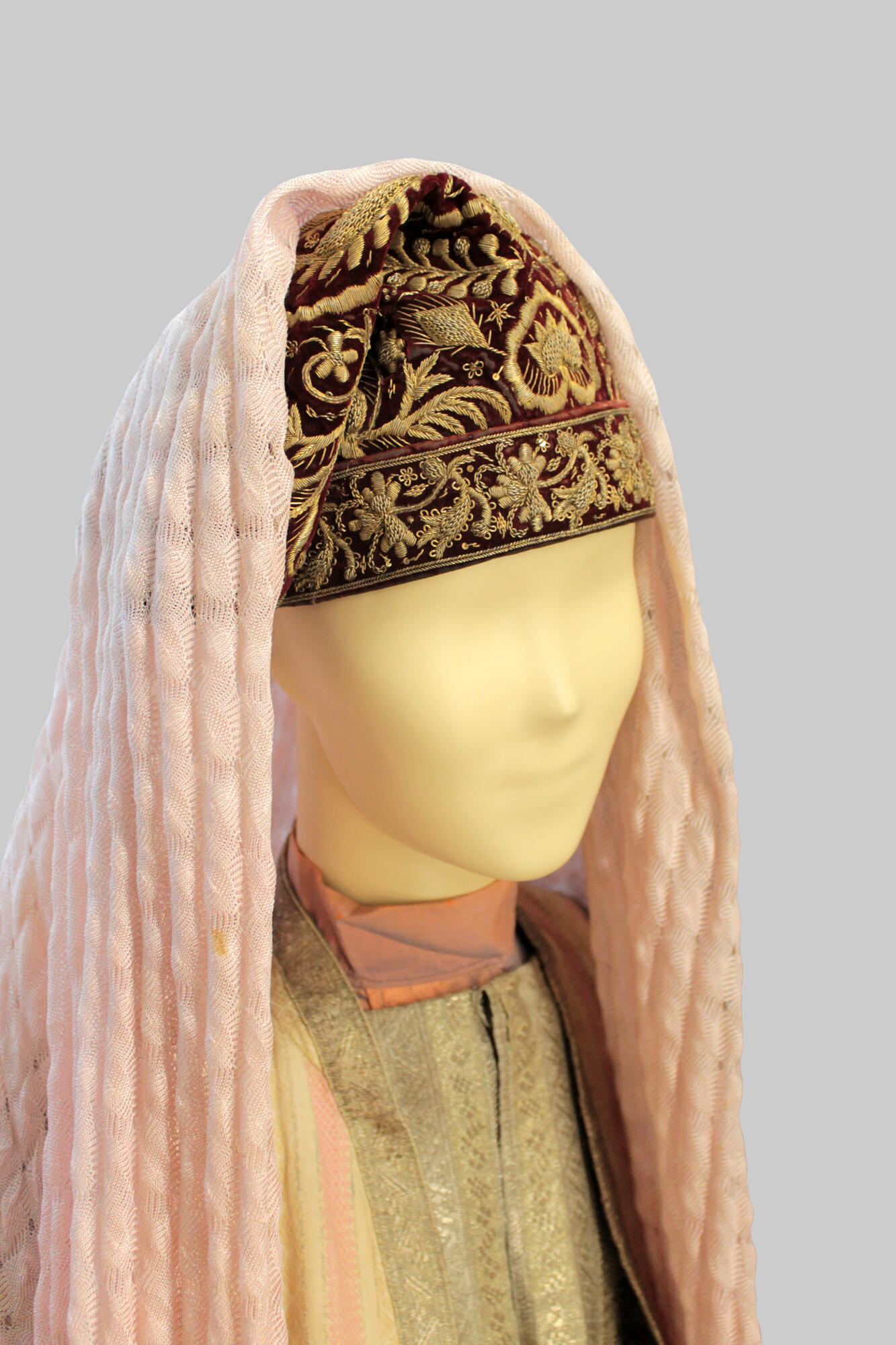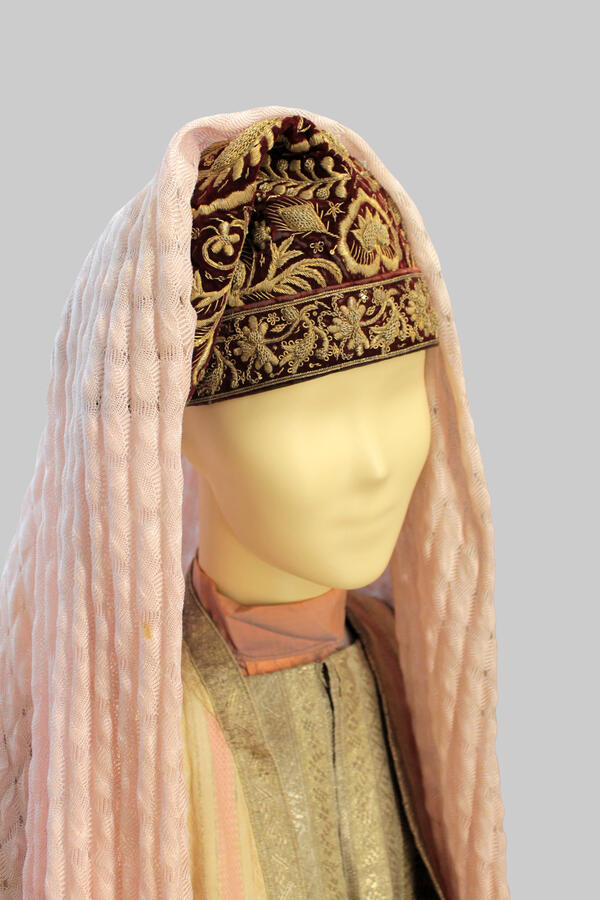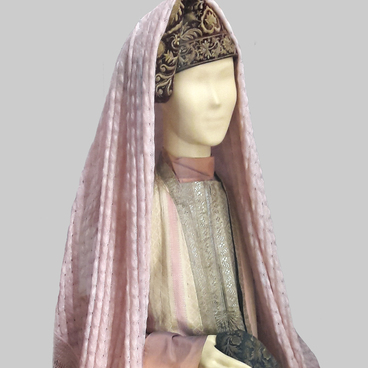A kalfak is a Tatar female headdress for girls and women There were girls' kalfaks made without a hard browband (knitted, cloth, and something called kalfak-chachak), which looked like a long cap with a tassel at the end. It was worn on the head, and the tapered end was folded back (or worn to the side). Girls' kalfaks were not covered with anything, except for the headband, which was part of the traditional set of this attire.
In the middle of the 19th century, kalfaks knitted from multi-colored silk threads with transverse stripes were also worn. Those are sometimes dubbed ‘urban’. The length of the kalfaks reached up to 50 cm. They did not have a hard band, but did have a lapel. Among those, some were richly ornamented with chenille embroidery and appliqués made using the ‘guide’ technique.
There was also a long garment knitted of white cotton threads, which was a stocking with a tassel at the end called an ‘ak kalfak’. When put on, that kind of kalfak was folded several times, thickening the edge of the garment. The fringe and crown of the kalfak were decorated with a geometric pattern.
Starting in the second half of the 19th century, velvet kalfaks with a hard band came into fashion in cities and the nearby suburbs. They differed in size, including the width of the band, its color, and decorative design. But with all this diversity, they still retained the function of headwear to be worn under something else: the kalfak was always worn on or fastened to the hair (closer to the forehead) and covered with a scarf on top. Wearing a kalfak by married women as stand-alone attire was only done with family, or in a circle of other women.
Regardless of size, the velvet kalfak consisted of two parts: a soft top and a hard band. These kalfaks were richly decorated with gold embroidery, regular embroidery, beads, and fresh-water pearls. The pattern on the band usually differed from the pattern on the lobes of the kalfak, which indicated the constituent nature of the garment. The soft lobe on this kind of kalfak was not put on the head but stayed flat and hung down on the side. There are many similarities in terms of the technique used to decorate and the composition of the pattern on both large and medium velvet headdresses. The pattern was floral, and most often it was a bouquet (one large or several small ones). Gold embroidery is often combined with an appliqué made of gilded coins that act as petals or leaves.
The territory where velvet kalfaks originated is Kazan and the area around Kazan, where their production took on the nature of a business. At the beginning of the 20th century, kalfaks, in conjunction with factory-made scarves, were called the national dress of Tatar women.
In the middle of the 19th century, kalfaks knitted from multi-colored silk threads with transverse stripes were also worn. Those are sometimes dubbed ‘urban’. The length of the kalfaks reached up to 50 cm. They did not have a hard band, but did have a lapel. Among those, some were richly ornamented with chenille embroidery and appliqués made using the ‘guide’ technique.
There was also a long garment knitted of white cotton threads, which was a stocking with a tassel at the end called an ‘ak kalfak’. When put on, that kind of kalfak was folded several times, thickening the edge of the garment. The fringe and crown of the kalfak were decorated with a geometric pattern.
Starting in the second half of the 19th century, velvet kalfaks with a hard band came into fashion in cities and the nearby suburbs. They differed in size, including the width of the band, its color, and decorative design. But with all this diversity, they still retained the function of headwear to be worn under something else: the kalfak was always worn on or fastened to the hair (closer to the forehead) and covered with a scarf on top. Wearing a kalfak by married women as stand-alone attire was only done with family, or in a circle of other women.
Regardless of size, the velvet kalfak consisted of two parts: a soft top and a hard band. These kalfaks were richly decorated with gold embroidery, regular embroidery, beads, and fresh-water pearls. The pattern on the band usually differed from the pattern on the lobes of the kalfak, which indicated the constituent nature of the garment. The soft lobe on this kind of kalfak was not put on the head but stayed flat and hung down on the side. There are many similarities in terms of the technique used to decorate and the composition of the pattern on both large and medium velvet headdresses. The pattern was floral, and most often it was a bouquet (one large or several small ones). Gold embroidery is often combined with an appliqué made of gilded coins that act as petals or leaves.
The territory where velvet kalfaks originated is Kazan and the area around Kazan, where their production took on the nature of a business. At the beginning of the 20th century, kalfaks, in conjunction with factory-made scarves, were called the national dress of Tatar women.



